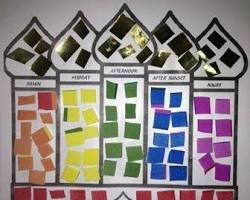The rich world of Islamic art offers a stunning blend of mathematics, geometry, and vibrant colors. It’s a captivating realm to explore for children of all ages.
This art form transcends mere aesthetics, often incorporating messages of faith and cultural traditions.
Engaging kids in Islamic art projects isn’t just about crafting; it’s a journey of discovery, fostering creativity and appreciation for diverse cultures.
Here are 20 Islamic art ideas designed to ignite your child’s artistic spirit:
Dazzling Diya Decorations:


Diyas, oil lamps used during festivals like Eid, are a beautiful canvas for creativity. Provide paints, markers, and glitter. Let children decorate with geometric patterns or motifs inspired by nature – a crescent moon and stars for Eid, or vibrant florals.
Mesmerizing Mosque Silhouettes:

Mosques, with their intricate domes and minarets, are iconic symbols of Islamic architecture. Cut out simple mosque shapes from black construction paper. Children can then use white glue and glitter to add dazzling details. Hang them for a touch of Islamic art in your home.
Stained Glass Magic:

Islamic art utilizes stained glass to create breathtaking effects in mosques. Replicate this magic with a simple craft! Use clear contact paper on a sturdy sheet of cardboard. Let children cut out shapes in colored tissue paper and stick them onto the contact paper, creating their own “stained glass” masterpiece.
Geometric Paper Tile Art:

Geometric patterns are a cornerstone of Islamic art. Cut out squares from colorful construction paper. Kids can fold them in half diagonally and create intricate repeating patterns by cutting out shapes. Unfold to reveal a beautiful geometric design!
Mosque Mosaic Masterpieces:

Mosaics are another stunning feature of Islamic architecture. Provide cardboard cutouts of mosques and various colored construction paper squares. Encourage children to create their own mosaic mosques, fostering visual-spatial skills.
Whirling Dervish Dancers:

The whirling dervishes, known for their meditative dances, are a captivating subject. Cut out large circles from white paper. Children can paint flowing robes and add swirling lines to represent movement.
Moon and Star Mobiles:

The crescent moon and star are powerful symbols in Islam. Use paper plates, paint, string, and glitter to create mobiles. Let children decorate the plates in vibrant colors and add glitter for a touch of sparkle.
Arabic Alphabet Adventures:

The Arabic alphabet is visually stunning. Print out large Arabic letter templates. Children can paint them and add embellishments, sparking interest in another language and cultural script.
Islamic Pattern Coloring Pages:

Download or create coloring pages featuring Islamic geometric patterns. This is a simple yet engaging activity, introducing children to the beauty and complexity of the art form.
Luminous Lantern Luminaries:

Lanterns are often used during Islamic celebrations. Provide paper lunch bags and tissue paper in various colors. Let children decorate the bags with geometric patterns or traditional Islamic motifs. Place a battery-operated tea light inside for a warm, glowing effect.
Mosque Model Mania:

Cardboard boxes are a treasure trove of crafting possibilities! Transform a box into a basic mosque model. Children can paint it, add paper cut-out minarets, and decorate the “dome” with glitter or mosaic patterns.
Stained Glass Cookies (for the taste buds too!)

Art doesn’t have to be limited to paper and paint! Make sugar cookies in geometric shapes. After baking and cooling, use colored icing to create beautiful stained glass designs on the cookies!
Storytelling with Sand Art:

Sand art bottles are a mesmerizing way to express creativity. Use clear plastic bottles, colorful sand, and funnels. Children can create Islamic-themed scenes – a mosque silhouette, a crescent moon rising over a desert landscape – using layers of colored sand.
Iftar Feast Placemats:

During Ramadan, families gather for the evening meal (Iftar). Create personalized placemats using construction paper. Children can decorate them with Islamic patterns, greetings like “Ramadan Kareem,” or illustrations of foods enjoyed during Iftar.
Islamic-Inspired Jewelry:

Islamic art often features intricate beadwork. Provide various colored beads, string, and clasps. Let children create their own bracelets or necklaces, incorporating geometric patterns or symbolic motifs.
Upcycled Gift Wrap:

Plain brown paper can be transformed into beautiful gift wrap! Use masking tape to create geometric patterns on the paper. Children can then paint the sections within the tape or
Magnificent Mehndi Murals (Temporary!):

Mehndi, the art of henna decoration, is a beautiful tradition in many Islamic cultures. While not permanent, creating temporary henna designs can be a fun activity. Use brown tempera paint or washable markers to create intricate floral patterns on children’s hands and arms (with adult supervision, of course!).
Islamic Architecture Scavenger Hunt:

Take a trip to a local library or museum with Islamic art exhibits. Prepare a scavenger hunt list with pictures or descriptions of elements of Islamic architecture, like geometric patterns, calligraphy, or specific mosque features. Let children embark on a fun learning adventure!
Storytelling Through Clay:

Clay offers endless creative possibilities. Provide modeling clay and sculpting tools. Children can create figures representing Islamic stories or historical figures (avoiding depictions of the Prophet Muhammad according to Islamic tradition).
Islamic Music and Movement:
Islamic music is rich and diverse. Play some for your children – calming instrumental pieces or uplifting devotional music. Encourage them to move and express themselves creatively through dance or body language, inspired by the music.
Bonus: Explore Islamic Art Apps and Websites:
Many educational apps and websites offer interactive features related to Islamic art. Explore these resources together. Children can create digital geometric patterns, color virtual mosques, or even try their hand at basic Arabic calligraphy.
Remember:
- Adapt the difficulty to the child’s age and skill level. Younger children may need more assistance, while older ones can handle more complex projects.
- Provide a variety of materials. Markers, paints, construction paper, glitter, beads – the possibilities are endless!
- Embrace the process, not just the product. Focus on the joy of creating and exploring Islamic art as a family.
- Learn together. Explore Islamic art history and traditions with your children. Visit museums, read books, or watch documentaries together.
By incorporating these Islamic art ideas into your child’s life, you’ll be fostering creativity, cultural appreciation, and a deeper understanding of the Islamic world. Let the journey begin!

